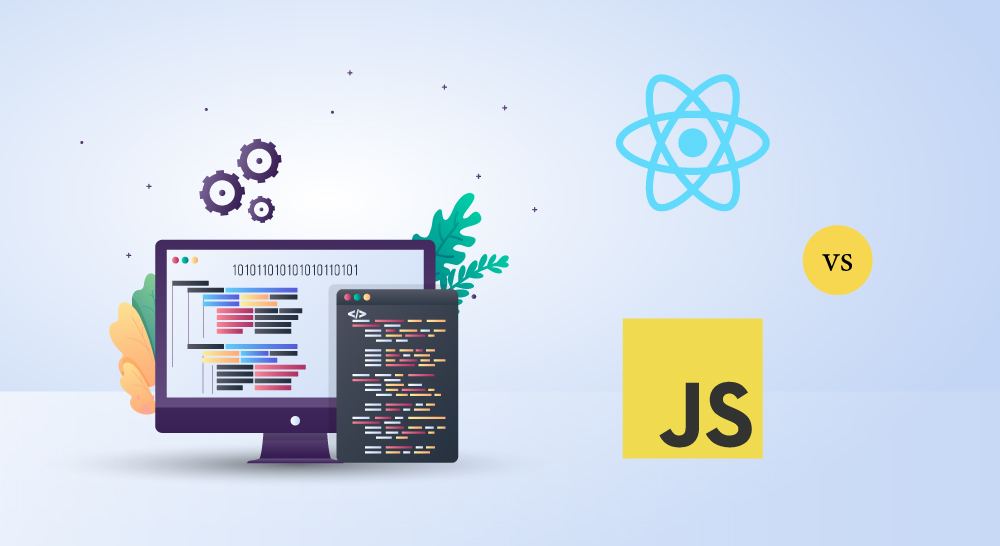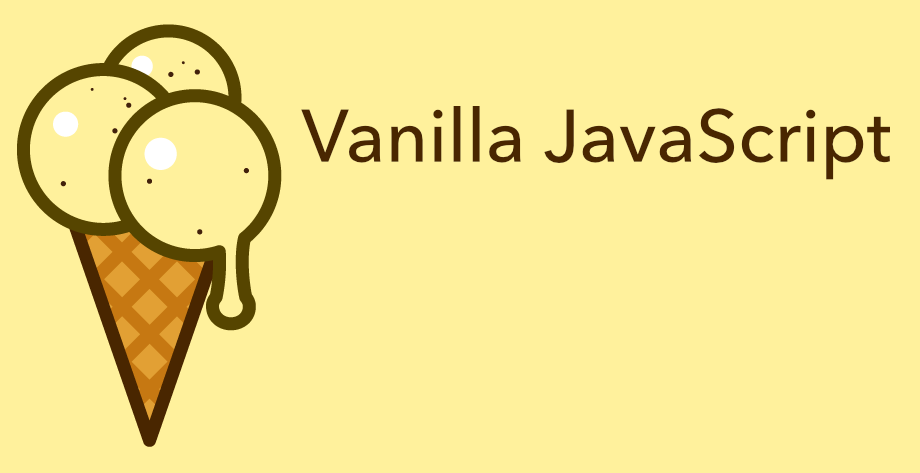If you’re a beginner web developer, you’ve probably come across the terms Vanilla Js and React. But probably aren’t sure what is what or which to implement to meet the needs of your website. This has a huge impact on your website and must be chosen carefully; therefore, understanding it well is crucial.
In this article, we’ll go through React vs Vanilla Js in depth so you can figure out which one to use for your desired website. Starting with what React and Vanilla Js are, what they’re used for, and the significant differences that may influence your selection. Let’s start with the fundamentals of React vs Vanilla Js.

What is React?
React is a Javascript-based User Interface library created by Facebook, a well-known social media company. It is widely used in the creation of user interfaces and interactive applications. The name “React” is suitable because the main goal of this library is to show how your website will react to a change in data.

By using React JavaScript, you create a bunch of independent components which are also reusable and later compose them to create a complex User Interface. Components are elements of your website that you combine to provide your users with the best possible experience. Components include the navigation bar, stories bar, and feeds.
As it is open-source, anybody can view the source codes and even edit them to enhance functionality. An open-source is always a likable option for the users as there is no hide-and-seek here. Thus there are limited privacy concerns regarding it.
Moreover, React allows you to debug any errors easily. It automatically finds the error in your page and fixes it with no hassle for the user at all. React is now one of the fastest-growing Javascript libraries, with a reputation for being extremely flexible and a time saver.
Who is React for?
To begin with, React is utilized to make your life easier. Imagine your page reloading after you’ve added a simple reaction to your friend’s newborn baby’s photo; it would certainly detract from the overall experience. This is where react comes in because rather than reloading the entire page, it simply refreshes the data on your webpage.
On your website, React is utilized to handle view layers. With a simple touch, you may easily express your website’s design and how each page will appear.
It effectively removes the need for you to create every line of code yourself and simplifies the process.
React JavaScript is always available if you need to create dynamic web applications. It’s a virtual DOM that aids in the development of dynamic web applications by generating a lightweight DOM from Javascript and preserving it on the web.
The Javascript Library also makes use of reusable components, which speeds up development. Let’s imagine you’ve made a button for your website; you can reuse it anywhere on your site without having to make a new one. It improves the dependability of your individual button because you’ve already tested it and know it’s free of bugs.
What is Vanilla Js?
Vanilla Js, also known as Plain Js, is just Javascript that does not require any other libraries but just pure coding. It’s fascinating to see how Plain Javascript became Vanilla Javascript. The use of external libraries had skyrocketed at the time.
Programmers have always been puzzled as to whether it was created using external Javascript or plain Java. Out of frustration, programmers devised a solution, which they called Vanilla Javascript.

The beauty of Vanilla Js is that you use the built-in Java language and not use other libraries or frameworks. Moreover, the frameworks are built over Vanilla Scripts. It’s a self-contained language that allows you to create your website or app without any boundaries meaning that you write those small codes to make a simple task, and the plus point is it will work exactly the way you have programmed it to.
Vanilla Js, in a nutshell, is a text-based programming language that requires just a solid understanding to use its wholesome potential. Learning Java is the first step of your overwhelming programming career, and if you are just here for fun, then Vanilla is not for you.
Switching to Vanilla Js has substantially improved the front-end performance of companies like Netflix, so you know this weapon can be lethal or ineffective to you.
Who is Vanilla Js for?
Vanilla Javascript is the ultimate pick for you if you want to learn the language from the ground up. Knowing Vanilla Js will open your third eye when it comes to creativity, but if you don’t want to put in the time, an external framework like ‘React’ is a better option.
Programmers that are looking for a long-term answer should end up choosing Vanilla. External frameworks use a variety of Java Scripts that are difficult to adjust and, in the long run, are not worth it. Also, all frameworks are slower than Vanilla as it’s not that lightweight.
However, if you’re building a website with a lot of content, additional frameworks like React aren’t a good idea; instead, stick with Vanilla Javascript. Vanilla has a steep learning curve and a large amount of material to work with, so investing your time is critical.
Learning it from the scratch will give you a good understanding of how the frameworks work and will help you improve your programming skills. Regardless, everyone wants a developer that knows in-depth about it from the bottom up and is most likely to be relied upon.
React vs Vanilla Js – What is the Difference?
Knowing the difference between React JavaScript and Vanilla JavaScript is really essential for a developer. According to your needs, you can choose whose side you will be on the React Vs Vanilla Js war.
When it comes to ease of learning, React takes the cake thanks to its simplicity and the ability to create reusable components, which are very useful for newbies.
However, I strongly advise you to start with the fundamentals, which is the Vanilla Js. This has a steep hill to climb, but it’s well worth spending.
Eventually, whether you like React Js or Vanilla Js, it doesn’t matter if you don’t master one. Having additional materials from which to learn is the key to grasping any.
There are plenty of classes available for both Vanilla Js and React. You’ll be able to go through the decade with each of them. Although there are numerous courses available, it is generally recommended that you begin with YouTube videos. After you’ve determined if you’re interested in it or not, investing in courses is a sensible option.
Apart from the popularity of React, there are some core features. React includes a feature called Virtual Dom that, when paired with its lightweight nature and increased performance, makes it even more powerful. The virtual DOM detects changes in props and sends them on to the real DOM to facilitate rendering.
Integrating with other libraries can come in really handy. Jquery might not have the widgets that React has and vice versa. It has never been easier to integrate with React. With a few simple coding, you can easily integrate your React coding with others.
With its shortcodes, React takes the honor from Vanilla. Vanilla creates spaghetti with your codes, but Reacts need extremely minimal codes to perform. Furthermore, the Facebook-created library categorizes all of your codes, making it extremely easy to locate one.
So, if you know you need to alter a simple colon in your code, you no longer have to go through all of these lengthy scripts. Instead, using React, you simply identify the category you want to modify, and voilà, the alphabets you’re looking for are there.
Finally, both the React Js and Vanilla Js communities are close to one other. Both of them have sufficient programming communities to assist you, even if you have a minor misconception.
React Vs Vanilla Js – Which One wins?
In the epic Vanilla Js vs React battle, no one comes out on top. It actually depends on the needs of the individual. It’s like comparing your grilled cheese sandwich to cheese, with Vanilla Js representing the sandwich and React representing the cheese. It’s important to remember that React is part of the JavaScript library.
If you want to create some visually appealing user interfaces, React is the way to go. What you should be concerned about is that React’s surroundings are always changing, and you must always be up to date with what’s going on, or else you’ll have a great deal of trouble.
Whereas in Vanilla, it’s not as simple to learn everything, but once you do, there’s no one stopping you from going on vacation for a whole year and still being up to date. To be honest, you can consider this an advantage or a disadvantage. Keeping up with all of these latest developments can be quite beneficial in improving the usability of your application or website.
For newbies, the React plugin JSX has created a bubble. The JSX is running in the opposite direction to its motto, despite the fact that its major purpose is to keep things simple. The majority of newcomers have had difficulty understanding and applying JSX.
In contrast to Vanilla JavaScript, React is more reliant on others. As a result, be prepared to leverage various technologies in your project. However, when it comes to pros and cons, React Javascript surpasses Vanilla Javascript.
Frequently Asked Questions
There are a lot of misconceptions about React and Vanilla Js. We’ve compiled a list of commonly asked questions, along with thoughtful responses, to help you understand the fundamentals.
1. Can I use Vanilla JS With React?
Yes, you can, but it’s a night before going to bed procedure. You could require a widget that is only accessible in Vanilla Javascript for your project. The most effective method is to build a wrapper-based framework.
2. Can I use React with HTML?
Adding React components to your HTML site may be really useful at times. React has made it such that you can do it almost effortlessly with HTML. Therefore, yes, you can use HTML to integrate React. JSX, a React extension, which stands for JavaScript XML, is responsible for this.
3. Which JS framework is easiest to learn?
When comparing React to Vanilla Js, React is clearly easier to learn due to its user-friendliness. Simply said, it’s a drag-and-drop operation. However, when compared to all of the JS frameworks, Jquery is the most user-friendly due to its easy coding syntax. Its simplicity encourages basic animations that are simple enough for even a fourth-grader to grasp.
4. When should you use Vanilla JavaScript?
Yes, Vanilla Js is still in use. Vanilla is the approach to choose if your website has a lot of heavy content. Even though it is more difficult than learning a framework, it is rewarding. If you are willing to build a career here, Vanilla Js is widely relied upon by people looking for developers.
5. Can I migrate to React from other libraries?
Yes, it can be easily done with React. It has allowed users to migrate easily with their smooth system. But it also increases the risk, so it’s better to know the DOs and Don’ts before migrating to React.
Final Thoughts
React vs Vanilla Js- the war has been out there for quite a while. In two opposing perspectives, both win. Now it’s up to you to decide which of them will win. The trick is to know what you want to acquire.
Well, if all you want to do is hook up, you already know React is the way to go. You won’t have to spend much time trying to figure it out. Apart from that, it’s also a good idea to connect apps on your website with a seamless UI.
Vanilla Js is a good choice if you want to dig deep while still having a lot of things to work with. It is preferable to other frameworks in terms of time spent on it.
Learning it from scratch will give you a good understanding of how the frameworks work and will help you improve your programming skills. Regardless, everyone wants a developer that knows in-depth about it from the bottom up and is most likely to be relied upon.

One comment on “React Vs Vanilla Js | The Ultimate Comparison”
Comments are closed.